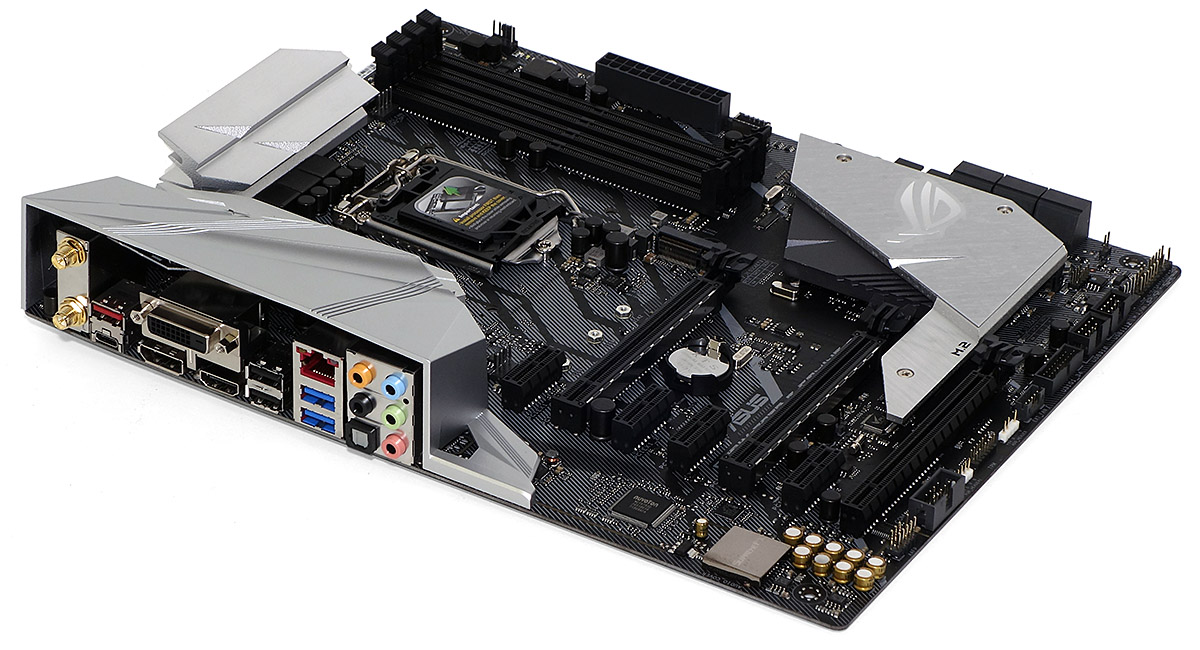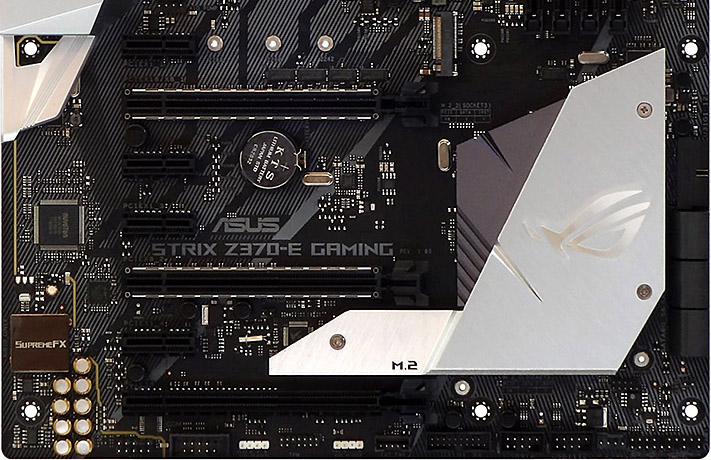Early Verdict
This board mixes good performance with an optimal layout for its included features. Hardcore overclockers might take pause, but buyers interested in its specific feature set will be pleased with this board's feature balance.
Pros
- +
Dual USB 3.1 Gen2 controllers
- +
Installed 867Mb/s Wi-Fi/Bluetooth controller Great performance
- +
Fewer shared interfaces than some other boards
- +
Shared slots are the ones hidden by graphics cards
Cons
- -
So-so CPU overclocking
- -
Not price-aggressive
Why you can trust Tom's Hardware
Features & Layout
We’ve been breaking motherboards into our own defined market segments for a few years, at least since before the boards themselves quit doing some "breaking" of their own. By which we mean: Motherboard prices went up when the PC-enthusiast market broke away from traditional PCs, and since then anything marketed for less than $160 has typically been equipped with only relatively basic features. The middle market, designed to satisfy most performance enthusiasts, has crept up to a rough range of $160 to $220, while a complete set of high-end features generally costs a bit over $220. And the wild stuff typically happens past $280.
With that said, the Strix Z370-E Gaming is priced at around $210. So, is this a better value in a high-end board, or just a mainstream overclocking board with a few added features? Let's take a closer look.
The single light bar on the board hints that it’s not designed for serious show-offs, but that’s okay with us. Lots of people are more interested in what a board can do than with what it looks like. And besides, there’s nothing unsightly about brushed-aluminum heat sinks or a plastic I/O connector cover that’s been painted silver to match.
Specifications
A quick look over the specs shows primarily high-end intentions, with two ASM3142 controllers that separately provide Type-C and Type-A ports to the rear, and a newfangled USB 3.1 Gen2 header for the front, all at 10Gb/s. Sharing has even been minimized to allow all the SATA ports and M.2 slots to work simultaneously with certain configurations; the second M.2 port (the one under the heat sink) can be set to two lanes to enable the SATA ports it steals, and the upper M.2 only requires an SATA port if its filled with a SATA drive. Performance enthusiasts are all about the NVMe at this point, often reserving SATA for backup drives.
Even with those things in mind, it’s hard to ignore some of the port choices on the I/O panel. Do enthusiasts need three outputs for the CPU’s onboard graphics? Why are there only six total USB ports, when users who want to use the rear-panel USB 3.1 Gen2 will often reserve those two ports for portable devices? Why is there no CLR_CMOS button? And considering that this is an Asus-made enthusiast board, why isn’t there any USB BIOS Flashback?
That last-mentioned omission suggests “because this is an enthusiast-level mainstream board” rather than a true high-end offering. And that's fine, for what it is. In a search for things that would boost it to the top of the mainstream segment—where its price resides—we find an RTL8822BE 2x2 (867Mb/s) controller with Bluetooth 4.2, in Key-E format, mounted to a custom riser card that also holds its antenna connectors. That’s something. It might even be worth $20, to those who want it. And it’s certainly nice to have that feature on the I/O panel, where it won’t occupy valuable slot space.
That means the rest of the board, in theory, only needs to compete against products around $190. And that's a much easier hill to climb, particularly considering its dual USB 3.1 Gen2 controllers. We can also see that the two metal-sided PCIe x16 expansion slots, which automatically switch from x16/x0 to x8/x8 modes when a second card is installed, are reinforced with soldered-down through-pins. The third long slot is connected via four lanes to the PCH.
Get Tom's Hardware's best news and in-depth reviews, straight to your inbox.
Another quick look back at the possible-configurations table shows that while the two-lane front-panel USB 3.1 Gen2 controller steals pathways from two PCIe slots, those two slots that get disabled are the ones directly under graphics cards. In other words, for most users of SLI or CrossFire, the two disabled slots were going to be covered up by graphics-card coolers anyway. You might think that’s not such a big deal, until you see that one of Asus’ biggest competitors hasn’t figured that out yet…on motherboards costing more than twice as much. Smart move, here, by Asus' designers.
The Strix Z370-E Gaming’s front-panel audio header is moved about an inch forward of its traditional corner to aid builders whose cables are a little short. There’s also a header for vintage serial-port breakout plates, which looks incongruous on a gaming-market motherboard, but we'll take it. Next to that are one of the board’s two RGB headers, a TPM header, an addressable LED, an Asus proprietary fan hub, one of the board’s two front-panel USB 3.0 headers, two USB 2.0 headers, and one of the board’s six fan headers. The front panel LED/button header contains a standard Intel pin layout, with PC Speaker and alternative (3-pin spaced) power LED segments added near the forward edge.
Five more fan headers surround the CPU, the second regular RGB LED header is located at the Strix Z370-E Gaming’s top edge, and all six SATA ports point forward, right next to the upper USB 3.0 front-panel header, to avoid mechanical interference with long expansion cards. Additional mounting points are placed in key locations for optional 3D-printable shrouds.
In the box, the Strix Z370-E Gaming includes a load of gear. You get four SATA cables, RGB LED and addressable-LED extension cables, a thermistor lead, a Wi-Fi antenna, an HB-SLI bridge, a CPU installation tool, a CPU fan holder, cable ties, documentation, a driver/application disc, the I/O shield, a doorknob hanger card, and stickers.
MORE: Best Motherboards
MORE: How To Choose A Motherboard
MORE: All Motherboard Content
-
jpe1701 @termathor- they still haven't had an update to fix the broken ai suite app either. It was broken after the spectre/meltdown windows patch came out. It contains the fan control software so I had to find a new way or use the BIOS.Reply -
Crashman Reply
OK, we got the patched firmware tested on the next Asus board, Z370-F. Unfortunately, adding the windows patches breaks some of our benchmarks. We're producing an entirely fresh software installation with all the recent patches installed, probably to be used in the next Z-series platform launch. Adding it at this point would make it impossible to compare previously-tested Z370 to new Z370 samples.20830868 said:@termathor- they still haven't had an update to fix the broken ai suite app either. It was broken after the spectre/meltdown windows patch came out. It contains the fan control software so I had to find a new way or use the BIOS. -
hendrickhere I used this in my new build and I'm pretty happy with it. Compared to the competition it's features...looked like the competition. Aesthetically it's quite nice looking and the RBGs aren't over the top. The M.2 shield is a nice touch, however, one of the screws was stripped so I couldn't easily remove it and had to use the M.2 slot below the CPU. It's probably just as well though as the M.2 under the shield is directly under the GPU anyway.Reply -
Pure-Soul What about the Audio and Microphone quality?Reply
I had faced a lack of mic quality in the past with some of ROG motherboards.






